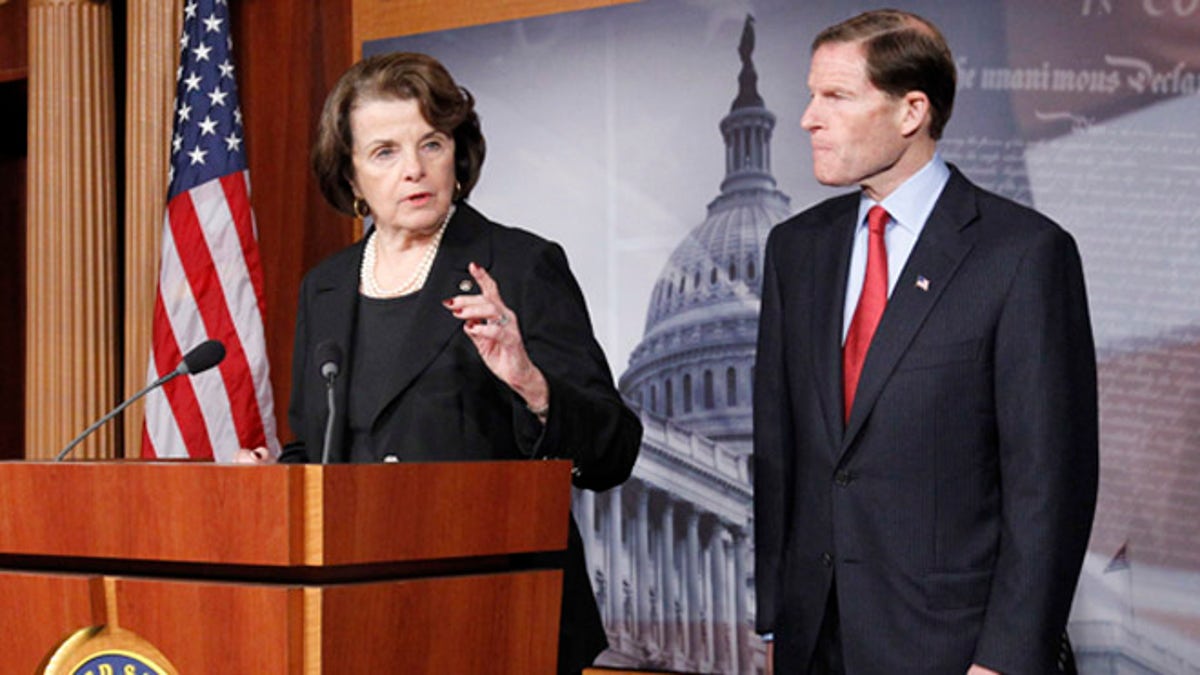
Dec. 21, 2012: Sen. Dianne Feinstein, left, speaks as she and Sen. Richard Blumenthal, right, discuss gun control on Capitol Hill. (AP)
Congress is poised to launch into a contentious debate next year over reinstating the assault-weapons ban.
In the wake of the Connecticut elementary school massacre, Sen. Dianne Feinstein, D-Calif., already has vowed to introduce such a bill at the start of the session. President Obama is voicing support.
But crime trends over the past few decades offer a mixed verdict on whether renewing the ban would reduce the kinds of mass shootings that have spurred calls for its re-enactment in the first place.
Data published earlier this year showed that while the ban was in place, from 1994 to 2004, the number of mass shootings actually rose slightly during that period.
Add to that the fact that most gun crimes in America are committed with handguns, and the gun lobby enters this debate with some potent statistics.
"You had that for 10 years when Dianne Feinstein passed that ban in '94. It was on the books. Columbine occurred right in the middle of it. It didn't make any difference," NRA chief Wayne LaPierre argued in an interview Sunday. "I think that is a phony piece of legislation, and I do not believe it will pass for this reason."
At the same time, gun control advocates note that modest decreases in assault-weapon crimes were recorded during the ban. A revived version won't stop gun crime in America, but, advocates argue, it could spare some lives from the violence on America's streets, in its schools and in its homes.
"You see the enormous killing power that's out there on the streets for virtually anybody to buy or obtain," Feinstein said last week.
A look exclusively at mass shootings -- the acts that typically prompt calls for more gun control -- shows a negligible impact from the Clinton-era ban.
Crime stats compiled by a Northeastern University professor, the Census Bureau and the Milwaukee Journal Sentinel show the number of mass shootings since the 1980s has fluctuated annually, but without any major upward or downward trend.
From 1985-1994, there were 173 mass shootings and 766 victims. From 1995-2004 (starting with 1995 because it was the first full year the law was in effect), there were 182 mass shootings and 830 victims.
After the ban expired, the average number of mass shootings every year continued to tick up slightly. The numbers were published over the summer in the Journal Sentinel, and counted a mass shooting as any murder where four or more people were killed at once.
The pro-gun-control Brady Center to Prevent Gun Violence argues the ban had more of an impact than it's given credit for. The group claims that in the five years before the ban, the affected weapons made up 4.8 percent of crime guns traced by ATF officials. Since the ban, that number dropped to 1.6 percent.
"This decline is extremely significant to law enforcement and has clearly enhanced public safety, especially since these military-style weapons are among the deadliest ever sold on the civilian market," the group claims.
Feinstein's office also claims the ban can be traced to a 6.7 percent decline "in total gun murders."
Even so, as the NRA points out, only a "tiny fraction" of crimes involve assault weapons no matter how it's measured. And a number of factors are at play, covering everything from policing to the state of the economy. According to the Justice Department, gun-related homicides overall have declined since they peaked in 1993. That decline is mostly attributed to a drop in murders involving handguns, which fell from nearly 14,000 in 1993 to close to 9,000 a decade later.
Both sides of this debate have pointed to several reasons why the assault-weapons ban was limited in its effectiveness. Aside from the fact that handguns are the most prevalent in violent crime, the assault-weapons ban included an array of exemptions.
To qualify as a semiautomatic assault weapon, a semiautomatic rifle had to have a detachable magazine and two or more of five specific features -- including a grenade launcher and a bayonet mount. Some gun makers simply modified their weapons to avoid qualifying under this definition.
A November report by the Congressional Research Service noted that opponents argued the banned guns "were potentially no more lethal than other semiautomatic firearms."
In addition, the law allowed people to keep semiautomatic weapons that they had before it took effect. The saturation of firearms in the country limited the impact of the ban. If the same law were passed today, that means more than 300 million firearms -- or one gun for every person in America -- would still be floating around.
It's possible that drafters of a new bill will try to modify it going forward. But any assault-weapons ban already faces dim prospects in the Republican-controlled House. An even stricter ban has even dimmer prospects. Indeed, Feinstein announced last week that her newest proposal would exempt more than 900 weapons.
Everything from mental health to school security to the entertainment industry is likely to be examined in the weeks ahead. LaPierre has rejected calls for gun control, and he urged the country to scrutinize the video game industry, while ramping up school security -- LaPierre wants an armed officer in every school.
Others, though, say gun control in some form has to be part of this discussion.
"There are countries that have mental illness, that have video games. They don't have the problem with guns the United States has," Democratic strategist Richard Goodstein said. "That's the big variable."





















